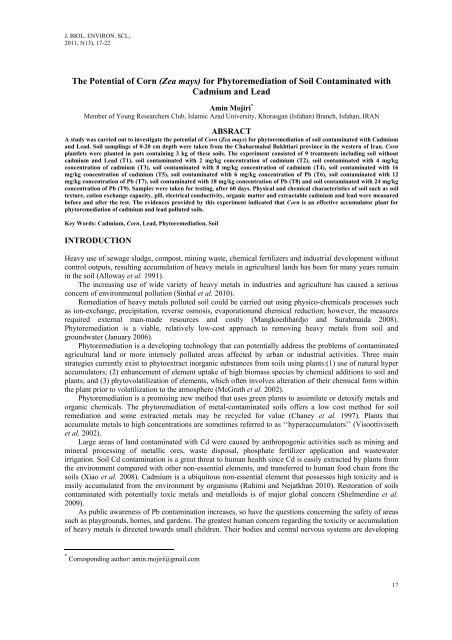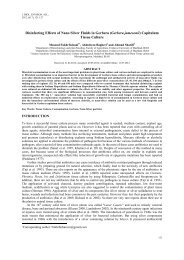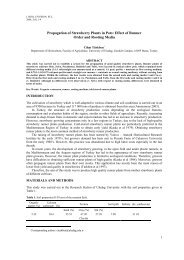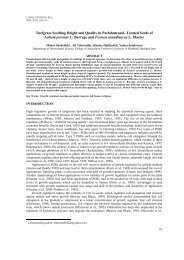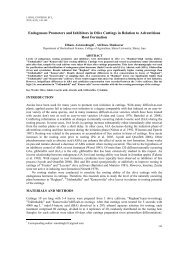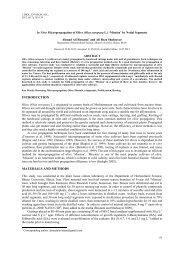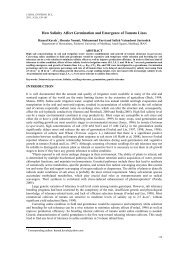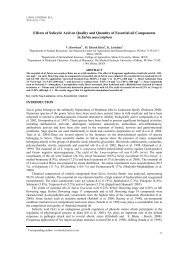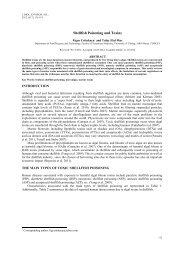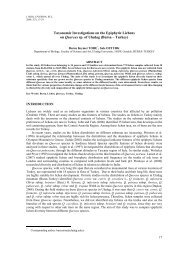The Potential of Corn (Zea mays) for Phytoremediation of Soil ...
The Potential of Corn (Zea mays) for Phytoremediation of Soil ...
The Potential of Corn (Zea mays) for Phytoremediation of Soil ...
Create successful ePaper yourself
Turn your PDF publications into a flip-book with our unique Google optimized e-Paper software.
J. BIOL. ENVIRON. SCI.,<br />
2011, 5(13), 17-22<br />
<strong>The</strong> <strong>Potential</strong> <strong>of</strong> <strong>Corn</strong> (<strong>Zea</strong> <strong>mays</strong>) <strong>for</strong> <strong>Phytoremediation</strong> <strong>of</strong> <strong>Soil</strong> Contaminated with<br />
Cadmium and Lead<br />
Amin Mojiri *<br />
Member <strong>of</strong> Young Researchers Club, Islamic Azad University, Khorasgan (Isfahan) Branch, Isfahan, IRAN<br />
ABSRACT<br />
A study was carried out to investigate the potential <strong>of</strong> <strong>Corn</strong> (<strong>Zea</strong> <strong>mays</strong>) <strong>for</strong> phytoremediation <strong>of</strong> soil contaminated with Cadmium<br />
and Lead. <strong>Soil</strong> samplings <strong>of</strong> 0-20 cm depth were taken from the Chaharmahal Bakhtiari province in the western <strong>of</strong> Iran. <strong>Corn</strong><br />
plantlets were planted in pots containing 3 kg <strong>of</strong> these soils. <strong>The</strong> experiment consisted <strong>of</strong> 9 treatments including soil without<br />
cadmium and Lead (T1), soil contaminated with 2 mg/kg concentration <strong>of</strong> cadmium (T2), soil contaminated with 4 mg/kg<br />
concentration <strong>of</strong> cadmium (T3), soil contaminated with 8 mg/kg concentration <strong>of</strong> cadmium (T4), soil contaminated with 16<br />
mg/kg concentration <strong>of</strong> cadmium (T5), soil contaminated with 6 mg/kg concentration <strong>of</strong> Pb (T6), soil contaminated with 12<br />
mg/kg concentration <strong>of</strong> Pb (T7), soil contaminated with 18 mg/kg concentration <strong>of</strong> Pb (T8) and soil contaminated with 24 mg/kg<br />
concentration <strong>of</strong> Pb (T9). Samples were taken <strong>for</strong> testing, after 60 days. Physical and chemical characteristics <strong>of</strong> soil such as soil<br />
texture, cation exchange capacity, pH, electrical conductivity, organic matter and extractable cadmium and lead were measured<br />
be<strong>for</strong>e and after the test. <strong>The</strong> evidences provided by this experiment indicated that <strong>Corn</strong> is an effective accumulator plant <strong>for</strong><br />
phytoremediation <strong>of</strong> cadmium and lead polluted soils.<br />
Key Words: Cadmium, <strong>Corn</strong>, Lead, <strong>Phytoremediation</strong>, <strong>Soil</strong><br />
INTRODUCTION<br />
Heavy use <strong>of</strong> sewage sludge, compost, mining waste, chemical fertilizers and industrial development without<br />
control outputs, resulting accumulation <strong>of</strong> heavy metals in agricultural lands has been <strong>for</strong> many years remain<br />
in the soil (Alloway et al. 1991).<br />
<strong>The</strong> increasing use <strong>of</strong> wide variety <strong>of</strong> heavy metals in industries and agriculture has caused a serious<br />
concern <strong>of</strong> environmental pollution (Sinhal et al. 2010).<br />
Remediation <strong>of</strong> heavy metals polluted soil could be carried out using physico-chemicals processes such<br />
as ion-exchange, precipitation, reverse osmosis, evaporationand chemical reduction; however, the measures<br />
required external man-made resources and costly (Mangkoedihardjo and Surahmaida 2008).<br />
<strong>Phytoremediation</strong> is a viable, relatively low-cost approach to removing heavy metals from soil and<br />
groundwater (January 2006).<br />
<strong>Phytoremediation</strong> is a developing technology that can potentially address the problems <strong>of</strong> contaminated<br />
agricultural land or more intensely polluted areas affected by urban or industrial activities. Three main<br />
strategies currently exist to phytoextract inorganic substances from soils using plants:(1) use <strong>of</strong> natural hyper<br />
accumulators; (2) enhancement <strong>of</strong> element uptake <strong>of</strong> high biomass species by chemical additions to soil and<br />
plants; and (3) phytovolatilization <strong>of</strong> elements, which <strong>of</strong>ten involves alteration <strong>of</strong> their chemical <strong>for</strong>m within<br />
the plant prior to volatilization to the atmosphere (McGrath et al. 2002).<br />
<strong>Phytoremediation</strong> is a promising new method that uses green plants to assimilate or detoxify metals and<br />
organic chemicals. <strong>The</strong> phytoremediation <strong>of</strong> metal-contaminated soils <strong>of</strong>fers a low cost method <strong>for</strong> soil<br />
remediation and some extracted metals may be recycled <strong>for</strong> value (Chaney et al. 1997). Plants that<br />
accumulate metals to high concentrations are sometimes referred to as ‘‘hyperaccumulators’’ (Visoottiviseth<br />
et al. 2002).<br />
Large areas <strong>of</strong> land contaminated with Cd were caused by anthropogenic activities such as mining and<br />
mineral processing <strong>of</strong> metallic ores, waste disposal, phosphate fertilizer application and wastewater<br />
irrigation. <strong>Soil</strong> Cd contamination is a great threat to human health since Cd is easily extracted by plants from<br />
the environment compared with other non-essential elements, and transferred to human food chain from the<br />
soils (Xiao et al. 2008). Cadmium is a ubiquitous non-essential element that possesses high toxicity and is<br />
easily accumulated from the environment by organisms (Rahimi and Nejatkhan 2010). Restoration <strong>of</strong> soils<br />
contaminated with potentially toxic metals and metalloids is <strong>of</strong> major global concern (Shelmerdine et al.<br />
2009).<br />
As public awareness <strong>of</strong> Pb contamination increases, so have the questions concerning the safety <strong>of</strong> areas<br />
such as playgrounds, homes, and gardens. <strong>The</strong> greatest human concern regarding the toxicity or accumulation<br />
<strong>of</strong> heavy metals is directed towards small children. <strong>The</strong>ir bodies and central nervous systems are developing<br />
* Corresponding author: amin.mojiri@gmail.com<br />
17
J. BIOL. ENVIRON. SCI.,<br />
2011, 5(13), 17-22<br />
rapidly and any exposure to Pb, even blood levels as low as 10 μg/dL (0.1 ppm), can cause long-term health<br />
problems within many organ systems and mental and physical impairment (Succuro 2010).<br />
Khodaverdi and Homai (2008) investigated modeling <strong>of</strong> phytoremediation <strong>of</strong> soil contaminated with<br />
Cadmium and Lead. <strong>The</strong>ir results showed that the increasing soil contamination with Pb increased<br />
phytoremediation <strong>of</strong> Pb from soil by Barbarea verna and Spinacia Oleracea L. but increasing soil<br />
contamination with Cd did not change phytoremediation <strong>of</strong> cadmium from soil by Barbarea verna and<br />
Spinacia Oleracea L.<br />
Cho-Ruk et al. (2006) investigated perennial plants in the phytoremediation <strong>of</strong> Lead-contaminated soils.<br />
<strong>The</strong>ir results showed that A.philaxeroides had the ability to extract an approximately 1.3-1.8 times greater<br />
amount than P. grandiflora and S. procumbens.<br />
In this study the potential <strong>of</strong> <strong>Corn</strong> (<strong>Zea</strong> <strong>mays</strong>) <strong>for</strong> phytoremediation <strong>of</strong> soil contaminated with Cadmium<br />
and Lead has been investigated.<br />
MATERIALS AND METHODS<br />
Site description, Sample preparation<br />
<strong>The</strong> experiment was carried out at green house. <strong>Soil</strong> samplings <strong>of</strong> 0-20 cm depth were taken from<br />
Chaharmahal Bakhtiari province in the western <strong>of</strong> Iran. <strong>Soil</strong> samples were allowed to air dry in a green house<br />
at a temperature between 25ºC and 30ºC and were then ground to pass a 2-mm mesh sieve <strong>for</strong> prepared <strong>of</strong><br />
soil samples (Makoi and Verplancke 2010) and <strong>Corn</strong> plantlets were planted in pots containing 3 kg <strong>of</strong> these<br />
soils. <strong>The</strong> experiment consisted <strong>of</strong> 9 treatments including soil without cadmium and Lead (T1), soil<br />
contaminated with 2 mg/kg concentration <strong>of</strong> cadmium (T2), soil contaminated with 4 mg/kg concentration <strong>of</strong><br />
cadmium (T3), soil contaminated with 8 mg/kg concentration <strong>of</strong> cadmium (T4), soil contaminated with 16<br />
mg/kg concentration <strong>of</strong> cadmium (T5), soil contaminated with 6 mg/kg concentration <strong>of</strong> Pb (T6), soil<br />
contaminated with 12 mg/kg concentration <strong>of</strong> Pb (T7), soil contaminated with 18 mg/kg concentration <strong>of</strong> Pb<br />
(T8) and soil contaminated with 24 mg/kg concentration <strong>of</strong> Pb (T9). Samples were taken <strong>for</strong> testing, after 60<br />
days.<br />
Laboratory determinations<br />
Physical and chemical characteristics <strong>of</strong> soil such as soil texture, cation exchange capacity (CEC), soil<br />
reaction (pH), electrical conductivity (EC), organic matter (OM), extractable Cadmium and Lead were<br />
measured be<strong>for</strong>e and after the test. <strong>Soil</strong> texture was determined by the Bouyoucos hydrometer method (Gee<br />
and Bauder 1986). <strong>Soil</strong> pH and EC were measured on 1:1 extract (<strong>Soil</strong>:Water). Extractable Cadmium and<br />
Lead (Pb) in soil samples were carried out by DTPA in accordance the Standard Methods (APHA 1998). <strong>Soil</strong><br />
OM was determined as in Walkley and Black and CEC was determined (ASA 1982).<br />
Statistical analysis<br />
Data will be analyzed using SPSS s<strong>of</strong>tware. Comparison between the average levels treatments will be<br />
per<strong>for</strong>med by Duncan’s test.<br />
RESULTS AND DISCUSSION<br />
<strong>Soil</strong> properties be<strong>for</strong>e experiment, comparing the means <strong>of</strong> Cadmium treatments in soil, comparing the means<br />
<strong>of</strong> Cadmium treatments in <strong>Corn</strong>, comparing the means <strong>of</strong> Lead treatments in soil and comparing the means <strong>of</strong><br />
Lead treatments in <strong>Corn</strong> are shown in Tables 1, 2, 3, 4 and 5, respectively.<br />
Table 1. <strong>Soil</strong> properties be<strong>for</strong>e experiment<br />
EC CEC OM Clay Sand Silt Fe Cd Pb<br />
pH<br />
(dSm - ) (me/100g) (%) (%) (%) (%) (ppm) (ppm) (ppm)<br />
Main <strong>Soil</strong><br />
6.99 1.11 9.5 0.70 10.00 60.90 29.10 2.50 0 0<br />
18
J. BIOL. ENVIRON. SCI.,<br />
2011, 5(13), 17-22<br />
<strong>Phytoremediation</strong> <strong>of</strong> Cadmium<br />
As known, the exchangeable <strong>for</strong>m Cd is easily absorbed by plant. In the presence <strong>of</strong> vegetation, the<br />
exchangeable <strong>for</strong>m Cd was partly removed by plant uptake that accompanied with the intake <strong>of</strong> nutrition<br />
(Zhang et al. 2009).<br />
Cd-hyperaccumulating plant species, are almost the only ones that can grow in soil solutions containing<br />
Cd concentrations as high as 35 μmol/L (3.9 mg/L) (Brown et al., 1994; Xiao et al., 2008).<br />
A possible explanation could be the exchangeable <strong>for</strong>m Cd in planted soil was the predominant species<br />
<strong>for</strong> Cd uptake by plant (Zhang et al. 2009). Zhang et al. (2009) expressed: as the phytoextraction <strong>of</strong> Cd by<br />
maize, the percentage <strong>of</strong> exchangeable <strong>for</strong>m Cd decreased in the planted soil. Besides, plant root exudates<br />
and rhizosphere microorganisms accelerated the stability process <strong>of</strong> added Cd in soils, which might make the<br />
exchangeable <strong>for</strong>m trans<strong>for</strong>m to other relatively stable <strong>for</strong>ms such as organic <strong>for</strong>m and residual <strong>for</strong>m and<br />
might help reduce the harm <strong>of</strong> Cd to soil and water environment.<br />
Table 2. Comparing the means <strong>of</strong> Cd treatments in soil after 60 days<br />
Parameter<br />
Treatments<br />
T1 T2 T3 T4 T5<br />
Cd (ppm) 0.00a + 0.700b 1.857c 3.415d 14.25e<br />
+ Row means followed by the same letter are not significantly different at 0.05 probability level<br />
Figure 1. Changes <strong>of</strong> Cadmium in soil<br />
T1, T2, T3, T4 and T5 are treatments 1, 2, 3, 4 and 5, respectively<br />
A and B are soils be<strong>for</strong>e 60 days and after 60 days, respectively<br />
Table 3. Comparing the means <strong>of</strong> Cd treatments in corn<br />
Cd (ppm)<br />
<strong>Corn</strong><br />
Root<br />
Shoot<br />
0 (T1) 0a + 0f<br />
2 (T2) 5.1913b 1.3305g<br />
4 (T3) 8.6906c 2.7917h<br />
8 (T4) 15.4127d 3.5126i<br />
16 (T5) 9.7215e 5.5304j<br />
+ Row means followed by the same letter are not significantly different at 0.05 probability level<br />
19
J. BIOL. ENVIRON. SCI.,<br />
2011, 5(13), 17-22<br />
Figure 2. Changes <strong>of</strong> Cadmium in <strong>Corn</strong><br />
T1, T2, T3, T4 and T5 are treatments 1, 2, 3, 4 and 5, respectively<br />
R and S are Root and Shoot, respectively<br />
According to Tables 2, It was clear that the concentration <strong>of</strong> Cd significantly decreased in the planted<br />
soil after 60 days culture. Accumulation <strong>of</strong> cadmium in root is higher than in shoot, this showed that root <strong>of</strong><br />
<strong>Corn</strong> is more active than shoot to phytoremediation <strong>of</strong> cadmium. This is in line with finding <strong>of</strong> Zhang et al.<br />
(2009) and Xiao et al. (2008).<br />
Increasing soil contamination to 8 (ppm) increased phytoremediation <strong>of</strong> cadmium from soil by <strong>Corn</strong><br />
but increasing soil contamination to 16 (ppm) decreased phytoremediation <strong>of</strong> cadmium from soil by <strong>Corn</strong>.<br />
<strong>Phytoremediation</strong> <strong>of</strong> Lead<br />
Water soluble and exchangeable lead are the only fractions readily available <strong>for</strong> uptake by plants.<br />
Oxyhydroxides, organic, carbonate, and precipitated <strong>for</strong>ms <strong>of</strong> lead are the most strongly bound to the soil.<br />
<strong>The</strong> capacity <strong>of</strong> the soil to adsorb lead increases with increasing pH, cation exchange capacity (CEC), organic<br />
carbon content, soil/water Eh (redox potential) and phosphate levels. In the natural setting, lead<br />
hyperaccumulation has not been documented. However, certain plants have been identified which have the<br />
potential to uptake lead (Henry 2000).<br />
Table 4. Comparing the means <strong>of</strong> Pb treatments in soil after 60 days<br />
Treatments<br />
Parameter<br />
T1 T6 T7 T8 T9<br />
Pb (ppm) 0.00a + 3.64b 7.23c 10.80d 14.17e<br />
+ Row means followed by the same letter are not significantly different at 0.05 probability level<br />
Figure 3. Changes <strong>of</strong> Lead in soil<br />
T1, T2, T3, T4 and T5 are treatments 1, 6, 7, 8 and 9, respectively<br />
A and B are soils be<strong>for</strong>e 60 days and after 60 days, respectively<br />
20
J. BIOL. ENVIRON. SCI.,<br />
2011, 5(13), 17-22<br />
Table 5. Comparing the means <strong>of</strong> Pb treatments in corn<br />
Pb (ppm)<br />
<strong>Corn</strong><br />
Root<br />
Shoot<br />
0 (T1) 0a + 0f<br />
6 (T6) 4.9845b 1.3005g<br />
12 (T7) 11.6056c 3.0317h<br />
18 (T8) 16.3127d 5.4006i<br />
24 (T9) 19.4015e 6.3124j<br />
+ Row means followed by the same letter are not significantly different at 0.05 probability level<br />
Figure 4. Changes <strong>of</strong> Lead in <strong>Corn</strong><br />
T1, T2, T3, T4 and T5 are treatments 1, 6, 7, 8 and 9, respectively<br />
R and S are Root and Shoot, respectively<br />
According to Tables 4, It was clear that the concentration <strong>of</strong> extractable Pb significantly decreased in<br />
the planted soil after 60 days culture. It was clear that the concentration <strong>of</strong> extractable Lead in soil under all<br />
treatments dercreased between 39.2-40.9%.<br />
Accumulation <strong>of</strong> Pb in root is higher than in shoot, this showed that root <strong>of</strong> <strong>Corn</strong> is more active than<br />
shoot to phytoremediation <strong>of</strong> Lead. This is in line with findings <strong>of</strong> Parsadoost et al. (2008) and Cho-Ruk<br />
(2006).<br />
CONCLUSIONS<br />
<strong>The</strong> increasing use <strong>of</strong> wide variety <strong>of</strong> heavy metals in industries and agriculture has caused a serious concern<br />
<strong>of</strong> environmental pollution. <strong>Phytoremediation</strong> is a developing technology that can potentially address the<br />
problems <strong>of</strong> contaminated agricultural land or more intensely polluted areas affected by urban or industrial<br />
activities. <strong>Corn</strong> is an effective accumulator plant <strong>for</strong> phytoremediation <strong>of</strong> cadmium and lead polluted soils.<br />
REFERENCES<br />
Alloway BJ, and Jackson AP (1991). <strong>The</strong> behavior <strong>of</strong> heavy metals in sewage sludge amended soils. Journal <strong>of</strong> Science<br />
<strong>of</strong> the Total Environment. 100: 151-176.<br />
APHA (1998). Standard Methods <strong>for</strong> Examination <strong>of</strong> Water and Wastewater, 20th ed. American Public Health<br />
Association, Washington, DC, USA.<br />
ASA (1982). Methods <strong>of</strong> <strong>Soil</strong> Analysis. Part 2. Chemical and Microbiological Properties, 2nd edition, Page A.L. (Ed.),<br />
Agronomy Society <strong>of</strong> America.<br />
Brown SL, Chaney R L, Angle J S, Baker A J M (1994). <strong>Phytoremediation</strong> potential <strong>of</strong> Thlaspi caerulescens and bladder<br />
campion <strong>for</strong> zinc- and cadmium-contaminated soils. J. Environ. Qual. 23: 1151–1157.<br />
Chaney RL, Malik M, Li YM, Brown SL, Brewer EP, Anjel JS, and Baker AJ (1997). <strong>Phytoremediation</strong> <strong>of</strong> soil metals.<br />
Current Opinion in Biotechnology. 8(3): 279-284.<br />
Cho-Ruk K, Kurukote J, Supprung P, and Vctayasuporn S (2006). Perennial Plants in the <strong>Phytoremediation</strong> <strong>of</strong> Leadcontaminated<br />
<strong>Soil</strong>s. Biotecnology. 5(1): 1-4.<br />
Gee GW, and Bauder JW (1986). Particle-size analysis. In: Klute, A. (Ed.), Methods <strong>of</strong> <strong>Soil</strong> Analysis, Part 1. Physical<br />
and Mineralogical Methods, 2end ed., Agronomy 9, 383-411.<br />
21
J. BIOL. ENVIRON. SCI.,<br />
2011, 5(13), 17-22<br />
Henry JR (2000). An Overview <strong>of</strong> the <strong>Phytoremediation</strong> <strong>of</strong> Lead and Mercury. U.S. Environmental Protection Agency<br />
Office <strong>of</strong> Solid Waste and Emergency Response Technology Innovation <strong>of</strong>fice Washington, D.C.<br />
January MC (2006). Hydroponic <strong>Phytoremediation</strong> <strong>of</strong> Cd (III), Cr (III), Ni (II), As (V), and Fe (II) by HELIANTHUS<br />
ANNUUS. M.Sc. <strong>The</strong>sis, <strong>The</strong> Graduate Faculty <strong>of</strong> <strong>The</strong> University <strong>of</strong> Akron.<br />
Khodaverdi H, and Homai M (2008). investigated modeling <strong>of</strong> phytoremediation <strong>of</strong> soil contaminated with Cadmium and<br />
Lead. Science and Technology <strong>of</strong> Agriculture and Natural Resources. 42: 417-426 (in Persian).<br />
McGrath SP, Zhao J, and Lombi E (2002). <strong>Phytoremediation</strong> <strong>of</strong> metals, metalloids, and radionuclides. Advances in<br />
Agronomy, 75: 1-56.<br />
Makoi J, and Verplancke H (2010). Effect <strong>of</strong> gypsum placement on the physical chemical properties <strong>of</strong> a saline sandy<br />
loam soil. Australian Journal <strong>of</strong> Crop Science. 4(7): 556-563.<br />
Mangkoedihardjo S, and Surahmaida A (2008). Jatropha curcas L. <strong>for</strong> <strong>Phytoremediation</strong> <strong>of</strong> Lead and Cadmium Polluted<br />
<strong>Soil</strong>. World Applied Sciences Journal. 4 (4): 519-522.<br />
Parsadoost F, Bahreini Nejad B, Safari Sanjani AK, Kaboli MM (2008). <strong>Phytoremediation</strong> <strong>of</strong> lead with native rangeland<br />
plants in Irankoh polluted soils. Pajouhesh & Sazandegi. 75: 54-63 (in Persian).<br />
Rahimi B, Nejatkhah M P (2010). Availability, Accumulation and Elimination <strong>of</strong> Cadmium by Artemia urmiana in<br />
Different Salinities. J. BIOL. ENVIRON. SCI. 4(12):149-157.<br />
Shelmerdine A, Black C, McGrath S, and Young S (2009). Modelling phytoremediation by the hyperaccumulating fern,<br />
Pteris vittata, <strong>of</strong> soils historically contaminated with arsenic. Environmental Pollution. 157: 1589-1596.<br />
Sinhal VK, Srivastava A, and Singh VP (2010). EDTA and citric acid mediated phytoextraction <strong>of</strong> Zn, Cu, Pb and Cd<br />
through marigold (Tagetes erecta). Journal <strong>of</strong> Environmental Biology. 31: 255-259.<br />
Succuro JS (2010). <strong>The</strong> Effectiveness <strong>of</strong> Using Typha latifolia (Broadleaf Cattail) <strong>for</strong> <strong>Phytoremediation</strong> <strong>of</strong> Increased<br />
Levels <strong>of</strong> Lead-Contamination in <strong>Soil</strong>. M.Sc. <strong>The</strong>sis, <strong>The</strong> Graduate Faculty <strong>of</strong> <strong>The</strong> University <strong>of</strong> Akron.<br />
Visoottiviseth P, Francesconi K, and Sridokchan W (2002). <strong>The</strong> potential <strong>of</strong> Thai indigenous plant species <strong>for</strong> the<br />
phytoremediation <strong>of</strong> arsenic contaminated land. Environmental Pollution. 118: 453-461.<br />
Xiao X, Tongbin C, Zhizhuang A, and Mei L (2008). <strong>Potential</strong> <strong>of</strong> Pteris vittata L. <strong>for</strong> phytoremediation <strong>of</strong> sites cocontaminated<br />
with cadmium and arsenic: <strong>The</strong> tolerance and accumulation. Journal <strong>of</strong> Environmental Sciences. 20:<br />
62-67.<br />
Zhang H, Dang Z, Zheng LC, and Yi XY (2009). Remediation <strong>of</strong> soil co-contaminated with pyrene and cadmium by<br />
growing maize (<strong>Zea</strong> <strong>mays</strong> L.). Int. J. Environ. Sci. Tech. 6 (2): 249-258.<br />
22


